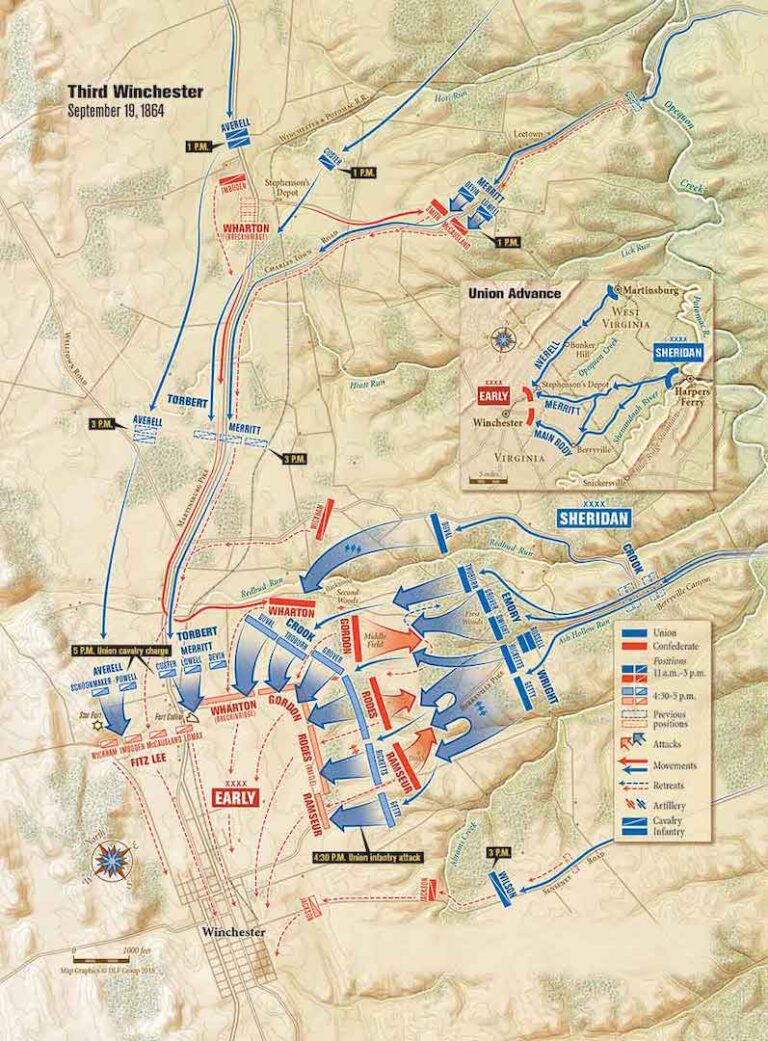The battle of Third Winchester took place on September 19, 1864. In the largest and bloodiest battle in the Valley, Union Gen. Philip Sheridan will attempt to clear the Shenandoah Valley once and for all as Confederate Gen. Jubal Early blocks his advance east of Winchester.
Located in the Northern Shenandoah Valley outside of the city of Winchester, today portions of the battlefield have been preserved by the American Battlefield Trust and the Shenandoah Valley Battlefield Foundation. Notable sites include the Middle Field and Second Woods.
This is the largest battle in the Shenandoah Valley and part of the last phase of the 1864 Valley Campaign also known as Sheridan’s Campaign. The battle included two future U.S. Presidents, two future governors of Virginia, a former U.S. Vice President, and a colonel who would be the grandfather to WWII legend George S. Patton Jr.
Part of Gen. Ulysses S. Grant’s overall wartime strategy was to clear the Shenandoah Valley once and for all while eliminating the breadbasket of the Confederacy and invasion route of the North. If effective, it will also threaten Gen. Robert E. Lee’s left and rear flank.
While Gen. Ulysses S. Grant was outside of the gates of Richmond at Petersburg, Confederate Gen. Jubal Early’s Army of the Valley in the Shenandoah Valley gave Washington much grief.
Union Gen Philip Sheridan was placed in charge of the Army of the Shenandoah and was strategically located between Gen. Early’s force in Winchester and Washington. On the eve of President Lincoln’s re-election in November 1864, Gen. Sheridan was cautioned to avoid a military disaster that would cause Lincoln votes.
However, in September of 1864, Gen. Sheridan saw an opportunity to strike against a portion of Gen. Early’s force east of Winchester. On September 19, 1864, a large slow moving Union force moving west along the Berryville Pike towards Winchester encountered Confederates at the Berryville Canyon.
This will delay the Union advance and allow Confederate Gen. Early to consolidate his largely outnumbered army along a strong ridge, running north to south, east of Winchester, and use the topography to his advantage.
The Union army had 40,000 while the Confederates defenders had 15,000. A general engagement ensued with a fury that day, especially at the Second Woods and Middle Field.
A large Federal assault was rebuffed by the Confederate veterans. Confederate Division commander Gen. Robert Rhodes and Union Division commander Gen. David Russell were killed a few hundred yards from each other during the intense engagement.
While the main Confederate line held steady against superior numbers, a late afternoon attack with fresh Union infantry and cavalry divisions descended from the north and smashed into the Confederate left flank. This attack will unhinge the Confederate line and drive them back towards their forts and defenses outside of Winchester
At the end of the day Gen. Alfred Torbert will lead a grand cavalry charge down the Valley Turnpike with infantry support and take the Star Fort, Fort Collier, and other surrounding defenses. This would cause the Confederates to retreat, running through the streets of Winchester, and ending the battle.
The bloodiest battle of the Valley will cost the Union 5,000 casualties including one general dead and two others wounded. Meanwhile, the Confederates will take 4,000 casualties, just over twenty-five percent, with two generals killed and four others wounded.
Third Winchester was the beginning of the end of the Confederate supremacy of the Valley. A series of Confederate defeats that fall will ensue which will help aid the reelection of President Lincoln.

Ready to explore the battlefield for yourself? Browse our full selection of American Civil War Battlefield Tours.
Please contact us if you have any questions about our tours or services.